 Aircrew Chronicles
Aircrew Chronicles  |
Aircrew Losses
|
Nose Art
|
BCATP
|
Lancaster
|
Media
|
Aircrew Losses
|
Nose Art
|
BCATP
|
Lancaster
|
Media
 Aircrew Chronicles
Aircrew Chronicles  |
Aircrew Losses
|
Nose Art
|
BCATP
|
Lancaster
|
Media
|
Aircrew Losses
|
Nose Art
|
BCATP
|
Lancaster
|
Media
Bomber Command Aircrew Chronicles
Barry Davidson had fewer than fifty hours in his pilot's logbook when he took off in a Blenheim IV (R8662) on a daylight raid with #18 Squadron. It was July 6, 1940 and he was ordered to bomb an enemy aerodrome in France. It was to be his first and only combat operation and the first day of almost five years as a POW.
|
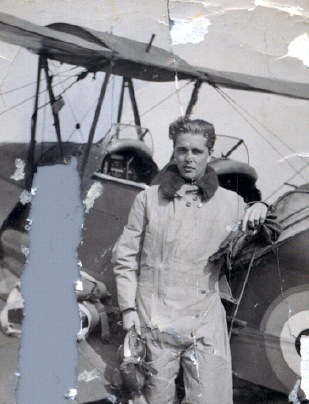
|
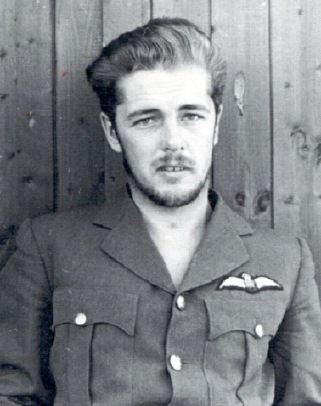
|
After successfully attacking the target the aircraft was struck by flak. With his elevators and compass out of action, P/O Davidson headed back across the English Channel. Upon reaching the coast, he put his Blenheim down on what he thought was an English beach and later recalled, "I was reading a map in the observer's position, trying to see where we might be in England .Suddenly I looked up and Germans were swarming down from the cliffs onto the beach." In a letter to his parents in Calgary he wrote, "Looks like I am in cold storage for the duration." After stints in various compounds he spent most of the war at Stalag Luft III, a vast air force prison camp near Sagan (in present-day Poland) built to house RAF POW's. Many of the prisoners, including Barry, felt that it was their duty to try to escape by any means possible in order to disrupt the enemy and to attempt to return to their duties in the armed forces. |
As the end of the war approached, the prisoners in Barry's camp were "force marched" for five days in -35 degree weather. The exhausted men were then put aboard crowded cattle trains for three days before spending the remainder of the war in cattle barns. Barry Davidson five year ordeal ended when he was liberated by a Scottish Tank Regiment on May 2, 1945.
Mr. Davidson returned to Calgary to work in the insurance business and raise a family. He was a charter member of the Calgary Prisoner of War Association and an active member of the Southern Alberta Aircrew Association until his death in 1996 at the age of 82.
|
Fellow POW's in Stalag Luft III referred to Barry Davidson as "The Scrounger" for his skill at obtaining necessary escape materials from the other side of the barbed wire. He used these talents in several break-out attempts, the best known of which was documented in Paul Brickhill's book, "The Great Escape, "which was later glamorized in a Hollywood film. In designing Stalag Luft III, the Germans raised the prison huts above ground to discourage tunnelling. Nevertheless the POW's were able to create trap doors under heating stoves. From there they chiselled through the huts' corner foundation pillars to create entrances for three tunnels nicknamed "Tom," "Dick," and "Harry." Some sand and soil was transported in bags, concealed in prisoners' trousers, to gardens. After a year of digging, and despite German discovery of "Tom," seventy-six men made it out through "Harry." The plan was for two hundred POWs to escape but German guards spotted the tunnel exit because it did not quite reach to a wooded area. Only three of the escapees eventually reached freedom. The rest were re-captured and, against the Geneva Convention, fifty were shot. Hitler himself gave this order. |
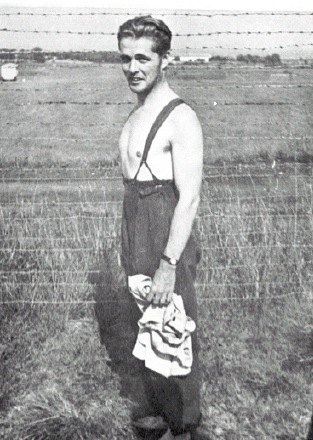 Barry Davidson at the fence. |
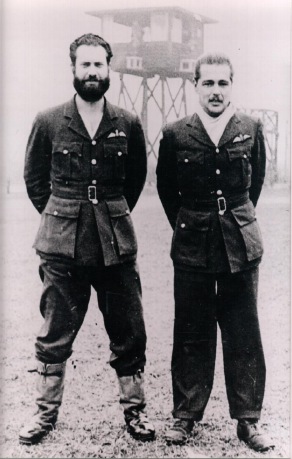 Hardie DeForest of Drumheller (left) and Barry Davidson. |
Barry Davidson specialized in bribing and blackmailing the "Goons" and "Ferrets" as prisoners called their German guards and hut searchers. The war deprived the guards of many things so prisoners like Barry were able to exchange chocolate, Nescafe, and cigarettes from their Red Cross packages for various things that were useful such as paper, India ink, pen nibs, and even a camera which were needed for forging travel papers for those who would be escaping. As well railway timetables, uniform insignias, passports, travel permits and even picks and timber for the tunnels were obtained. It was though these efforts that Barry was nick-named, "The Scrounger." His part was played by James Garner in the movie version of "The Great Escape." |
|
The Blenheim aircraft in the Bomber Command Museum has been restored in memory of Barry Davidson and carries the RAF markings of the aircraft he flew. As well as honouring Barry, it is a memorial to all those allied airmen who became Prisoners of War. The Blenheim IV also serves as an example of the aircraft used by Bomber Command during the first years of the war, prior to the development of four-engined heavy bombers such as the Lancaster. During this time crews such as Barry's set out in twin-engined Whitleys, Hampdens, Wellingtons and Blenheims with a compass being their only navigational aid to fly operations to Berlin and beyond. |
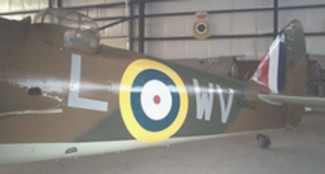
|